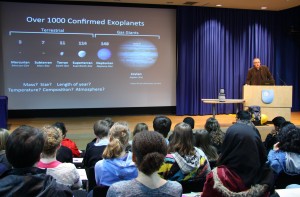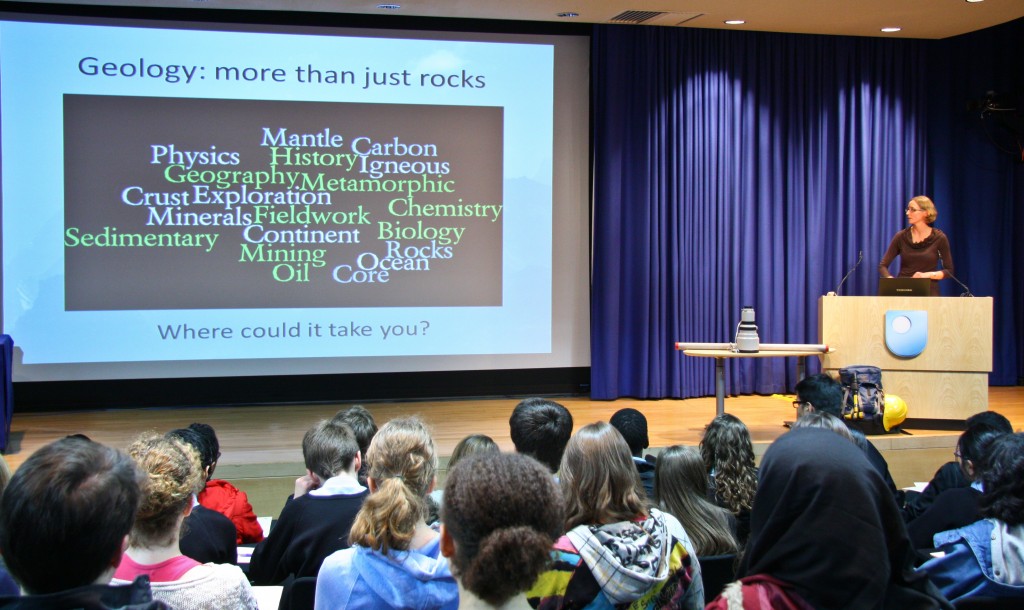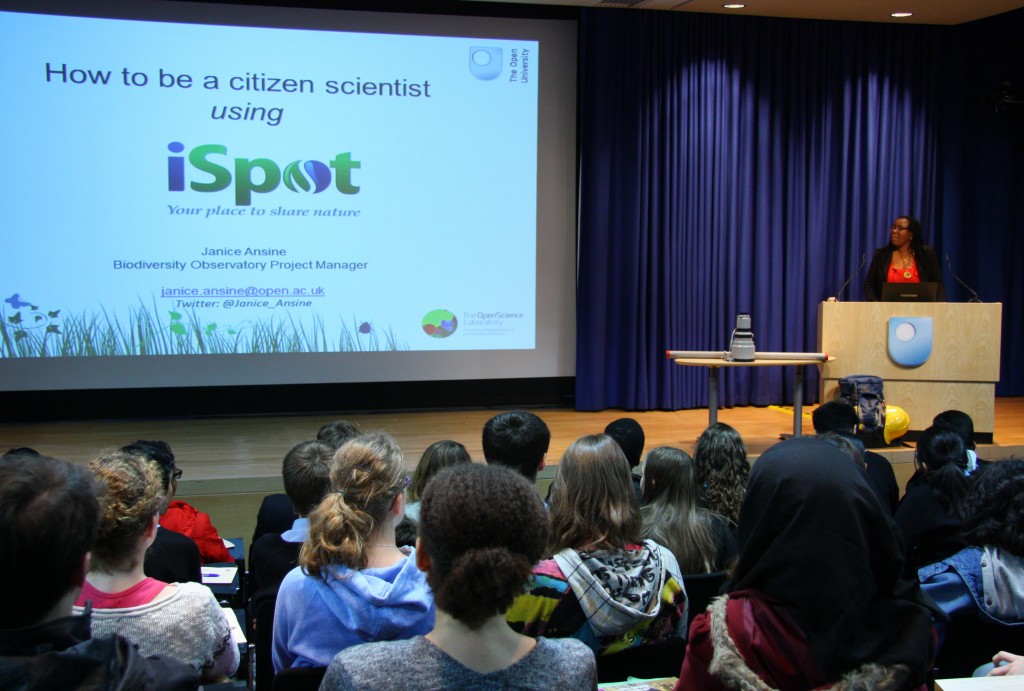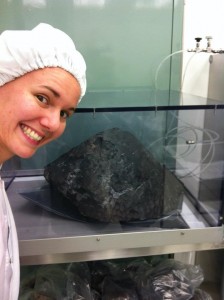By Robert Lambourne
Despite the many advances in information and communications technology, I would argue that there are still few, if any, ways of learning informally (and formally for that matter) about science that are as effective, stimulating or memorable as a really good public lecture.
Really good public lectures about science are rare, however. There is plenty of research evidence showing the relative ineffectiveness of most lectures, but the sense of ‘event’ that surrounds a lecture by an accomplished speaker is undeniable, and if to that is added fascinating content and good delivery then the whole concoction can be truly unforgettable.
This article is unlikely turn anyone into a great lecturer, but it will provide practical advice, based on personal experience gained from giving public science lectures about physics and astronomy, and from watching others give public lectures over many years. It is my sincere hope that such advice will help would-be public speakers to avoid some of the pitfalls that engender mis-communication between them and their audience.
A three card trick
The classic three stage formula for any public lecture is “first I tells ‘em what I’m going to tell ‘em, then I tells ‘em, then I tells ‘em what I told ‘em”. Such an approach is undeniably linear in essence—the ‘expert’ lectures to an audience, rather than interacting with them, in much the same way that this article does.
Let me start by saying that in what follows I shall divide the process of giving a public science lecture into three stages; the preparation, the presentation and the post-lecture follow-up. Since I am a strong believer in the value of structure I shall also try to divide each of those sections into clearly focussed ‘bite-sized’ chunks.
Preparation
Public lectures always start with the opportunity to lecture. This may arise from an unsolicited invitation or the lecturer may have deliberately created the opportunity. In either case there will usually be some freedom to choose the topic or at least the title of the lecture. My first piece of practical advice is choose both with care and don’t be stampeded into addressing a topic or accepting a title with which you are uncomfortable.
This is not to say that you have to be an expert on every subject when you promise to give a lecture on it. Sound subject knowledge should be the basis for any public lecture but in my own case I have often offered to give lectures on topics with which I am not fully familiar precisely to give myself the motivation to concentrate on that subject and get it into focus before (sometimes only just before) the lecture.
The title should be clear and broadly appealing to the audience, so you need to know your audience; a little thought about titles can dramatically alter the attractiveness of a lecture. If you doubt what I say then buy copies of quality and popular newspapers on the same day and compare the headlines of articles that report the same issue or topic.
It follows that ‘Introduction to Cosmology’ may sound formal and off-putting to some; the same lecture entitled ‘Understanding the Universe’ may be more likely to succeed. Similarly ‘Astronomical Spectroscopy’ is likely to be trumped by ‘Colour and the Stars’ for an audience who aren’t professional astronomers.
Having said that, don’t be afraid to incorporate technical terms that already enjoy a high degree of public recognition, particularly if they are widely recognized as ‘hot topics.’ A talk on ‘Superstrings’ is more likely to attract a popular audience than the familiar but staid ‘Electricity in the Home’. If you really want to talk about the latter, a perfectly good topic, then your first challenge is to find an informative but attractive title.
Also, don’t forget the value of the colon in clarifying titles: ‘Introduction to Cosmology’ may be off-putting, but ‘Cosmology: the Science of the Universe’ may have more appeal. Finally on the subject of titles, my personal view is that it’s usually best to avoid ‘smart’ or ‘funny’ titles. Unless you have a real talent for humour, these can fall flat and may lead to confusion.
Once the subject and title have been established you will need to plan the lecture. The nature of your plan will be dictated by your goals; are you trying to introduce your audience to the basic facts and findings of a subject, are you using your subject to illustrate some more general point such as the value of scientific research or the importance of scientific understanding, or are you interested in the social and ethical implications related to your research work.
Whatever your goals, keep them clearly in mind and use them to select the points you really want to emphasise and the messages you want the audience to take away. One of the key differences between a public lecture and a standard ‘teaching’ lecture is that most members of a public audience will not undertake any formal follow-up work or assessment, so what they gain from attending your lecture may be limited to what they remember as they leave the lecture. (Of course, some may choose to conduct follow-up research. Alternatively, you may provide some take-home resources.)
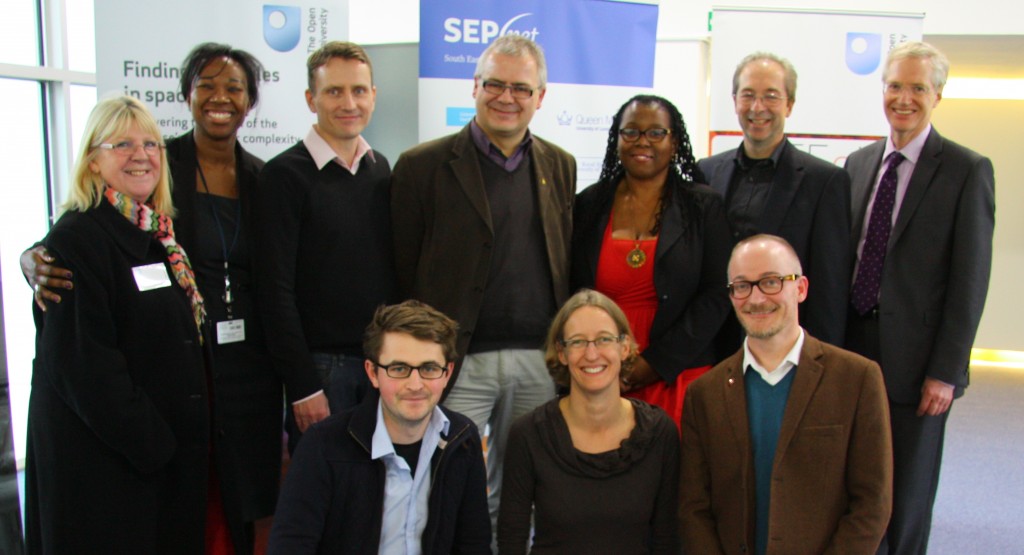
Back row, l-r: Janet Goss, Diane Ford, Andrew Norton, Janice Ansine, Simon Kelley and Tim Blackman. Front row, l-r: Frazer Bird, Clare Warren and Richard Holliman. Photo: Kate Bradshaw.
If you are trying to convey the importance of research, sending the audience away with the memory that you used a red light rather than a green one in some experiment is probably of much less value than giving them a reason to remember that it was research that led you to the conclusion that one would be better than the other.
As for writing down a lecture plan, I usually find that a list of six to ten ‘topics’ is sufficient for a fifty minute lecture, which should be the maximum length for a public lecture if you want to keep your audience engaged. This ensures that the lecture will be divided into chunks of six to eight minutes duration that should be relatively easily assimilated by most audience members. Limiting the number of ‘chunks’ usually involves being selective.
When planning a lecture I often start out by thinking ‘how on Earth can I speak for almost an hour on this topic?’ but by the time I have completed the plan I usually find myself asking ‘how can I fit all this into just 50 minutes?’ Having arrived at a plan I generally present it (or an abbreviated version of it) at the beginning of my lecture and talk my audience through it in the spirit of ‘I tells ‘em what I’m going to tell ‘em’. This gives you the chance to emphasise the important points right at the start.
Using slides
The standard support medium for a public science lecture is currently Microsoft PowerPoint or one of the equivalent computer packages which allows text and images (including movies) to be projected via a data projector or ‘beamer’ as it is known in Continental Western Europe.
Turning a lecture plan into a PowerPoint presentation usually involves gathering images and deciding on how much text to write to go with them. You will probably have your own preferences in these matters, and there are no hard and fast rules but here are a few points I usually find it useful to keep in mind.
- Keep the presentation clear and uncluttered without too many items on any given slide; don’t overlay text on pictures that might make it hard to read; don’t use too many fonts, and don’t overuse fancy transitions from one slide to another. In this instance, less really can be more; select words and images carefully to act as a shorthand to reinforce what you are saying.
- For readability use good-sized text; 24 point is usually reckoned to be the minimum for most presentations. Also, when projected, a sans-serif font such as Arial is more easily read than a serif font such as Times Roman.
- Make plenty of use of colour, but do so in a way that clarifies your subject. Use a consistent colour for key words or for alternate lines in a list; use colour to identify themes that run throughout your presentation. Avoid garishness.
- Think about audience members who suffer an occasional lapse of concentration. A few words of text or a title at the top of a slide may help them to understand what the slide is about, even if they failed to absorb your undoubtedly clear explanation.
- Pictures are vital in most lectures. It’s worth spending a lot of time finding the right ones. Learn how to use the ‘image search’ facilities provided by companies such as Google (http://www.google.co.uk/). You may also want to keep your own archive of useful images, but be aware of copyright issues and always give credit where it’s due.
- Including animated pictures (usually provided as .gif files) or short movie clips (typically .mpg or .avi files) can greatly improve a talk. Internet searches will probably show you what’s available and will also provide information about how to handle particular file formats.
- If using graphs, take care to make clear what is being measured on each axis as well as the significance of the overall form of the graph. If the graph includes several plotted lines use colour to distinguish them.
- Don’t avoid technical terms, but do take care to introduce them judiciously, in a measured way and with a clear definition. Also remember that what constitutes a technical term to a public audience may not be very ‘technical’ to you. An acquaintance of mine who is a mathematician was shocked when his own mother interrupted one of his verbal descriptions to ask if a sphere was the same as a globe.
- Make sure your slides don’t tell a completely different story from your lecture. Choose text and images that will reinforce what you are going to say and help to make it memorable.
Obviously, you should rehearse a lecture in advance so that you are sure you have got it to about the right length, and all the better if you can have an audience; perhaps a willing colleague or partner.
Don’t be afraid to cut deeply if you have to, or to add content or further explanation if you’re running short. If possible include some topics that you can jettison – just in case! Having taken the time to time a lecture I generally take questions at the end, and leave time for this. If you have greater flexibility in terms of timing you may want to take questions as the lecture unfolds.
Finally, never read from a script or paper as this is a pretty-much guaranteed formula if you want to lose the vast majority of the audience’s interest within five to ten minutes of you starting.
Presenting a public lecture
Do all you can to get to know the kind of audience you are addressing. If you discover that your visual aids are not appropriate for the audience, you can probably still save the day by speaking at an appropriate level from the outset. Be alert for restlessness or any of the other small signs that indicate you are hitting the wrong note. Incidentally, never underestimate an audience. Only after I had given several lectures at one venue did I learn that one of the regular audience members was a retired Nobel Laureate.
And, of course, others in the audience will bring their own knowledge, experiences, attitudes and beliefs to the lecture; that’s often why they are there. The whole point about a public lecture is that it’s public; you should not assume any technical expertise of your audience, but you should also expect on statistical grounds that some of them will be smarter and more distinguished than you are, and have other forms of relevant expertise.
The issue of dress can be a difficult one and it can be helpful to take the advice of the organisers into account when considering what to wear. Having said this, you need to feel comfortable and relaxed.
Personally, I still like to wear a jacket and tie when giving public lectures, and when attending a lecture I like to feel that the lecturer has gone to some trouble over his or her appearance. Some audience members still feel quite strongly about this issue though in my experience most do not. This is really a matter for you to decide, but at least give it some thought so that your appearance is a matter of conscious decision.
If possible, get all the necessary equipment (computers, projectors, experimental demonstrations, etc.) set up and checked in advance, and visit the venue if at all possible (even if this is just a virtual visit). If you are using your own computer make sure the venue is set up for that, in many cases they may expect you to have everything on a memory stick or a disc that can be inserted into their computer.
The problem of speakers finding that their computer will not ‘talk’ to a data projector is less common than it was but it still happens and causes great disruption when it does. If problems do arise try to get someone else to fix them for you while you keep the audience engaged.
If the only solution is to reboot everything, then do so, but always know at the start of a lecture what you will do in the event of a catastrophic equipment failure. You need a Plan B. Are you really going to send everyone home, are you ready to simply talk about your subject without any visual aids, or perhaps open up one or two issues for discussion following a short presentation?
Make clear at the start of your lecture how you want to handle questions. Do you want the audience to ask you questions during the lecture, are you planning to invite questions from time to time, or would you prefer to handle questions at the end? The choice is yours, but it’s generally a good idea to let the audience know what you prefer, and to plan for this.
Try to keep the answers to questions succinct. You may encounter a questioner that is on a completely different wavelength from you and members of your audience. Treat such questioners politely, but don’t be over-indulgent.
My own experience is that even if the lecturer is sympathetic to such questions some members of the audience may not be and will want you to move on quite quickly. If an answer is taking too long or getting into too much detail, offer to discuss it further after the lecture.
Try to speak in a lively and engaging way that can be easily heard throughout the lecture room. Don’t speak too quickly, and try to keep facing the audience while speaking.
Even if you have a good loud voice those with hearing impairment may want you to use a microphone connected to an induction loop system and they may need clues from your lips. If that’s the case, or you’re being audio or video recorded, ask for a clip microphone. This will allow you to move around without having to worry about where the microphone is.
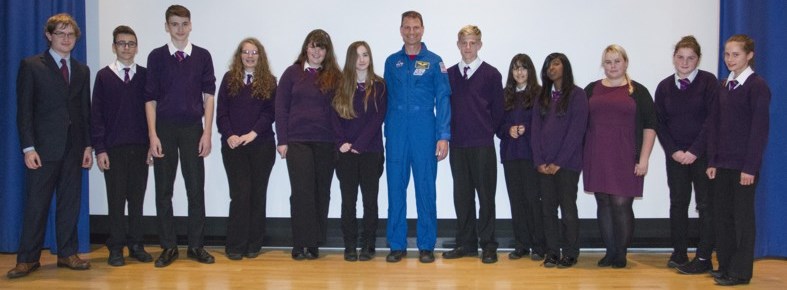
Students of St. Paul’s Catholic School in Milton Keynes had a chance to speak to NASA astronaut Stanley G. Love after his lecture. Image credit: Luke Beaman, OU.
If you are enthusiastic about your subject don’t be afraid to show it. Vary your tone, but remember that saying things loudly is not the only way to emphasise importance. If you observe professionally trained actors you will see that they sometimes drop their voices when delivering key lines; this is an alternative way of ensuring that an audience is listening carefully to an important point.
If you are worried that some may not hear at all you can always repeat the point afterwards. Repetition and reinforcement are usually appreciated by audiences, as are intermediate summaries of the ‘Where have we got to?’ variety.
Going over time is a major sin, especially if others are due to follow you. If you find timing difficult make sure you know at the start of a lecture what you will do if you find yourself in danger of overrunning. Do not make the false presumption that talking faster is an acceptable solution. This is only likely to frustrate the audience and illustrate that you haven’t planned the lecture as well as you should have.
Finally, in a public lecture it is usually a good idea to conclude with a summary; ‘tell ‘em what I said’ by focussing on the key take-home messages.
This post was originally part of the Isotope repository. Written by Robert Lambourne it has been reposted here with minor modifications.


